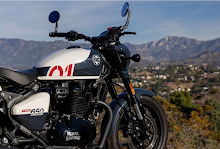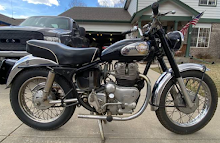 The Enfield Girl was a real person. She was probably very young, perhaps 15, when she started modeling for renown pin-up artist Gil Elvgren (1914-1980). Over the years she got a haircut and a new skirt. But there is no doubt that the pin-up girl astride the Royal Enfield motorcycle in the Classic Motorworks advertisement was originally the girl in the Elvgren painting Final Touch.
The Enfield Girl was a real person. She was probably very young, perhaps 15, when she started modeling for renown pin-up artist Gil Elvgren (1914-1980). Over the years she got a haircut and a new skirt. But there is no doubt that the pin-up girl astride the Royal Enfield motorcycle in the Classic Motorworks advertisement was originally the girl in the Elvgren painting Final Touch.She was just "clip art" when artist Ignacio Catral of Catral Doyle Creative in Milwaukee came across her. As he tells the story:
"At the time, we were in charge of developing a campaign for an amazing new kit that you could bolt on to the existing Bullet and create this fantastic café racer. We had a chance to spend some time with the bike during the photo shoot and we came up with the idea of this pin-up calendar shot with the bike in it. We had the bike shot already but no budget for another shoot and the pin-up talent. In our research we found the image of this girl straddling an artist’s horse, and knew she was the one. After finding the correct shot with the correct posture we had to treat the shot of the bike to match the existing technique of the pin-up illustration."

Elvgren produced fully finished paintings. He was at the head of his profession and well paid for the day, but his works weren't always treated with much respect. The cheap, double-entendre titles were provided by copy writers. Other artists were sometimes employed to "over-paint" the images, changing the models' clothes, for instance. The image could then be reused, without paying the original artist again.
Elvgren photographed his models. Pictures exist of the same basic pose with variations in dress. In the case of the Enfield Girl, the billowing skirt comes and goes in the photos. Our Enfield Girl wears a skirt closer to that seen in one of the photos. The Enfield Girl has been "flopped" and now extends her left arm to the right. Her hair is shorter and has lost the flower Elvgren added to his painting. The extended arm, eyes focused forward instead of at the viewer, and tip-toe high heels are constants.
 Elvgren enjoyed painting nudes, but most commissions were for girls who are adequately if not completely clad. There is always a hint of mischief in their eyes. The girl is clearly in on the joke; she knows what she is doing.
Elvgren enjoyed painting nudes, but most commissions were for girls who are adequately if not completely clad. There is always a hint of mischief in their eyes. The girl is clearly in on the joke; she knows what she is doing.Their youth is a bit disturbing. Elvgren said the finished pin-up would have the face of a 15-year-old and the body of a 20-year-old. He preferred models who were just starting out in their careers and so lacked poise. Elvgren chose the models for their faces. He could always add bigger busts and tighter waists and hair styles were kept simple so as to remain fashionable for as long as possible.
The model in Final Touch, which dates from perhaps 1954, is making her own painting, a pose that suggests that Elvgren might have momentarily run out of ideas and resorted to using his own studio. He felt that every imaginable idea had been used. He sought and shared ideas with other pin-up artists he knew and relied on his wife and family to come up with ideas.
Elvgren owned race cars and attended races. There are a few cars included as props in his pin-up paintings, but I didn't see any motorcycles. In that respect, the Enfield Girl fills an important gap.
























I wonder if the images were in public domain at the time and hense required no royalty payment?
ReplyDeleteAl in Philadelphia
Good question. The answer is that Ignacio Catral, creator of the Enfield Girl ad, specifically told me that the image came from a rights free CD. Interesting that what started as a masterly oil painting by a real artist gradually made its way to a sort of "clip art." On the other hand, I've linked here every which way I could figure to legitimate references to the original work. So, in a way, the Enfield Girl and artist Gil Elvgren are kept alive.
ReplyDelete